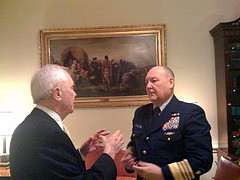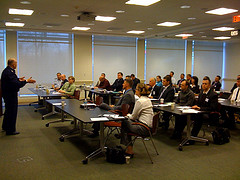My post, "
Why modernize? An Historical Perspective," introduced the first in a series of posts that chronicle our cause for action to modernize. Since then we have discussed "
MLC Realignment", "
WHEC to WMSL: Our Trackline to an Agile Mission Support Organization" and "
Human Resources and an efficient Coast Guard."
This installment, provided by RDML Keith Taylor, CG-8, focuses on our financial management systems. You have read previous posts where I discuss how we arrived at our current state over the last twenty years. This is a look at where we are going. A future post will discuss the current condition of the surface fleet. Through this series we hope to provide a comprehensive narrative that helps to explain where the Coast Guard is today, how we got here, and where modernization is intended to take us. It is important to understand that while I issued 10 Commandant Intent Action Orders in 2006, they are all linked to develop an improved mission execution and mission support structure. As RDML Taylor points out, you can't separate financial management from any facet of mission execution or support. You are an important part of that discussion. I have enjoyed reading your 30+ comments so far on this series and hope to hear more from you.
-----------
Guest Post by RDML Keith Taylor, CG-8 and CFO.
When I originally outlined this guest blog in my mind I was thinking it might be valuable to discuss some of the Coast Guard's financial management history in order to provide a context. But, as I began writing I decided to focus more on where we are today and where we are going with financial management. This is a complex subject with many related areas of emphasis, so I hope this first installment will serve as a jumping off point for a regular discourse on financial management.
Without a doubt, this is an exciting time to be in the Coast Guard. Never have we been more relevant to the Nation, providing maritime safety, security and stewardship around the clock and around the globe. Premier mission execution is always the goal. All of us in the Coast Guard remain steadfastly focused on that imperative...it is our "outcome" and we can never compromise that end-state. With that said, for many years we have had business processes and systems, including those involving financial management, that have not kept pace or been updated to serve us well today or into the future.
We must Modernize the Coast Guard and our cause for action is clear. We must also modernize financial management. These two efforts are inextricably linked. We cannot achieve the goals of Modernization without a modernized financial management enterprise (people, processes, systems, internal controls, organization structure, etc.). The new standardized Coast Guard business processes, including product line management, configuration control, bi-level support, enhanced acquisition structures, unified human capital management, all require a robust, sound and efficient financial management enterprise to be successful. After assessing where we are over the last several months, I am absolutely convinced that we cannot achieve required financial management improvements, including a "clean" audit opinion, without Coast Guard Modernization.
Without a long discussion of how we got here, we have some fundamental, structural deficiencies that are preventing us from achieving a financial audit opinion. For example we have multiple General Ledgers (The general ledger is where accounting transactions are posted as the official financial record of an organization). You have already heard the Commandant discuss the independent financial linkages between the Aviaiton Logistics Center and Coast Guard Yard with the Treasury. In and of itself that might not be a showstopper, but these ledgers are not integrated, are not compliant with U.S. Standard General Ledger criteria and are derived from separate financial systems. These financial systems do not meet federal standards for security, auditability and standardization. Over many years we have created a highly decentralized financial management execution structure. While the focus has been on maximizing operational flexibility at unit level (a very good thing), this philosophy has not served us well from a financial management perspective. People at our units spend too much time accounting for budget authority, making financial transactions and, then later also reconciling those transactions. Today we also lack the internal controls, the policy rigor and the information systems to support a modernized Coast Guard. We also lack a robust human capital strategy to ensure we have the financial management expertise we need to be successful in the future. Finally, and this is clearly my opinion, we have over the years not been rigorous with Financial Management Technical Authority and this has contributed to a severe lack of standardized policy, processes and systems that continue to hurt us today. When I use the term "Technical Authority" it is the same function that our engineers perform in regard to technical issues associated with building a new cutter. It involves an accountable, competent authority to insure appropriate standards are set, and that those standards are met. None of these issues are new, but they all must be addressed as we move forward.
In FY2008, as one major component of financial management modernization, the Vice Commandant chartered the Audit Readiness Planning Team (ARPT). Building upon deliberate remediation work completed in FY2006 and FY2007 and the foundational work of the Financial Management Transformation Task Force (FMTTF) that Admiral Allen chartered in one of his original Commandant Intent Action Orders, (CIAOs) this cross-functional ARPT team, working under my guidance, was comprised of senior CG, DHS and external subject matter experts. They addressed root cause conditions of our material weaknesses (identified in previous audits and our own self assessments) and developed a holistic, actionable plan focused on implementing effective internal controls, remediating and supporting financial reporting, achieving audit readiness, and improving accountability across the enterprise. This work resulted in Version 2.0 of our Financial Strategy for Transformation and Audit Readiness (FSTAR) and in close cooperation with the DHS CFO, we established the following focus areas for FY2009 and FY2010:
- Improving Entity Level Controls (this includes our organizational structure, leadership focus, control environment, etc. -- this is a complex subject that would be worthy of a future discussion) -- We will continue to enhance financial management governance and enterprise-wide management controls.
- Remediating Funds Balance with Treasury (think of this as our checking account with Treasury) -- Representing over $5B on our balance sheet, we will focus on reconciling Military Payroll transactions (over $3.7B of activity in FY2008) with both Treasury and our General Ledger. We have never been able to do this in our history and this represents a critical first step forward.
- Remediating Actuarial Pension Liabilities (this is the unfunded liability we carry on our balance sheet for estimated future military pension requirements) -- At over $25B (yes - $25 billion!) this is the largest line item on both the DHS and CG balance sheets. Fixing this is critical to a consolidated DHS clean audit opinion.
- Remediating General Property, Plant and Equipment (includes all of our cutters, aircraft, boats, shore plant, etc.) -- At over $8B (this is net, original cost less depreciation) this is the largest asset on our balance sheet and requires a two pronged effort -- fix the process we use for new assets as they come on-line and clean up the information concerning current assets. This area touches the entire CG.
This plan was developed in close coordination with the DHS CFO, has been reviewed by the DHS IG and OMB, and was delivered to Congress on December 1st as part of our Financial Management Improvement Plan (FMIP)
While the ARPT was underway, we continued to address weaknesses and made some noteworthy progress. First and foremost, and as reported in the DHS Independent Auditors report, the entity level controls finding for DHS was reduced from a material weakness to a significant deficiency (this is a big improvement in a financial audit) -- the DHS CFO told me directly that this would not have been possible without the strong effort and progress we made in the Coast Guard in this area. This is the first time since we joined DHS that we have reduced any of our material weaknesses.
We also achieved another first in FY2008 -- we fully supported our balance sheet investment balance of $2.9B. In essence, we were able to prove, to the high standard required, that the balance was complete, accurate and properly recorded. Not only was this significant for us, but this line item has a material impact on the DHS balance sheet and our effort moved the Department closer to an auditable position. We also fully supported our contingent legal liabilities balance on the FY2008 balance sheet. Finally, we continued to make substantive progress in the areas of military payroll reconciliation, property, plant and equipment, and construction in progress. We will continue to build upon this work as we execute FSTAR 2.0 and modernize our financial management enterprise.
As a close out of the FY2008 financial management cycle, and as an update to all hands on financial management modernization, I just released
ALCOAST 619/08. I hope you find it interesting and helpful. At the end of the day, we have a lot of work to do and we are underway on the correct course. Like Coast Guard Modernization, financial management modernization will be a multi-year effort that will make our Service fundamentally better and in the future equip our service with the authoritative information, systems and processes needed to make sound and transparent decisions.
I am excited by the opportunities in front of us...
Happy Holidays
Keith Taylor
Rear Admiral
Assistant Commandant for Resources
Chief Financial Officer










